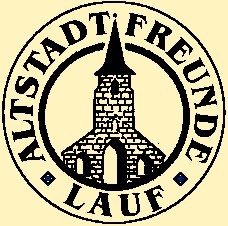Subterranean Lauf
The Cellars
Nearly every house bordering the market square in Lauf has a cellar cut into the sandstone bedrock. These cellars are situated mainly under the courtyards of the houses but along the north side some cellars extend under the alleyway (Mauergasse), some are also directly under the houses but none of the cellars extends under the market square.
The cellars are about 10 meters below street level and consist of chambers which have vaulted ceilings and large solid columns. The headroom in the cellars varies between 160 and 200 centimeters. Several cellar floors are only a few centimeters above the ground-water level so that when the river Pegnitz is high some cellar floors stand under water. Many cellars have their own wells, the shafts of which used to extend upwards to openings in the courtyards.
House No. 3 (a pharmacy) has not got a deep cellar as it was built more recently. From No. 4 (a dentist's) to No. 12 (the Commerzbank) it is possible to go from one cellar to the next as the cellars have all been joined together. This is also possible from No. 19 (a hotel) to No. 23 (a hairdresser's).
The cellars under the properties bordering the south side of the market square have yet to be explored and documented. It is known that there are cellars under the houses No. 38 (radio and TV) to No. 42 (a hotel), the latter also has a connection to Spitalgasse 4 (the "Lumpensammler" pub). No. 52 (a flower shop) and the "Red Bull" pub next door also have cellars.
Outside the historical centre the former "Ruprechtsgärtlein" Bahnhofstraße 4 (seed house) has a large cellar which has a connection (now sealed) to the cellar of the former cheese factory Saarstraße 5 (hairdresser).
History

The exact time of origin and history of the cellars is not known. From dates chiselled in the walls we can see that the cellars, as they now are, were completed between 1600 and 1680. As the cellars were always privately owned there are no public records. The earliest date chiselled into the rock is 1617 and we can assume that the cellars served as shelters in the Thirty Years War. The first documentary evidence dates from 1629 where, apart from the listing of the owners and their brewing rights, records were also made of the size and condition of their beer cellars. Into the 20th century they were used for storing beer as the temperature in the cellars is a constant 8 to 10 °C in summer and winter. They became redundant after the introduction of refrigerators. During the world wars their importance as air raid shelters was obvious and to allow escape, the cellars which were previously separate, were connected with one another. After the war they were used as a dump for rubble and rubbish and nearly sank into oblivion as some entrances were closed by structural alterations to the houses.
Over the last few years the cooperation of a few committed property owners with the Town Council and the Preservation Society has resulted in the installation of electric lighting in some cellars which have been cleared of rubble to allow guided tours to take place.
Guided tours may be arranged all the year round by contacting the Preservation Society (Altstadtfreunde Lauf, Phone 09123-184 174)
